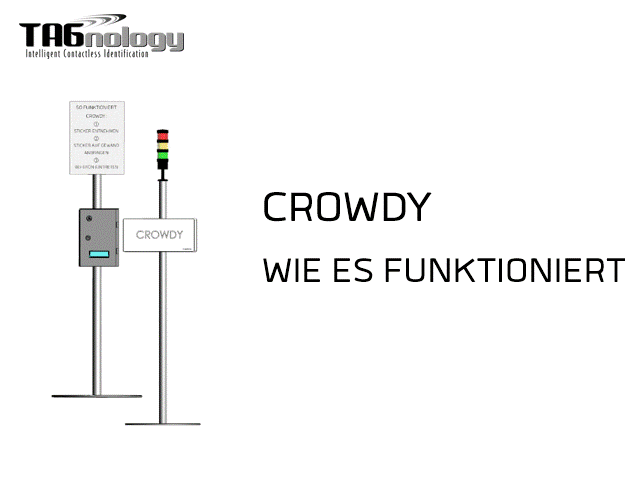While communities around the world began to emerge from the COVID-19 pandemic, the people at TAGnology, an Austrian provider of contactless identification solutions, were hard at work creating a fully automated system that helps stores reopen while complying with guidelines for social distancing.
The usual recommendation for social distancing is that, to help minimize the continued spread of the disease and keep people safe, individuals should maintain a distance of about one to two meters (or six to nine feet). Depending on the size of the store, that can mean allowing only one or two customers in at a time, or several dozen.
A Resource-intensive Process
There are several ways to regulate the number of people entering and exiting a retail outlet and store owners have been creative in their approaches. Some assign an employee to be a gatekeeper, only opening the door to admit customers when others leave, and some post an employee with a manual counter near the door, clicking entries and exits and pausing newcomers if the number of people in the store nears its limit. At larger retail outlets, the setup can be more involved. One door may be designated as an entry and one as an exit, each staffed by an employee monitoring door counts. When enough people have left the store, the employee at the exit signals to the employee at the entrance that it’s okay to let more in.
These are all effective ways to regulate traffic and limit the number of people in a store, but from an operational standpoint, they’re not particularly efficient. They all require the use of dedicated staff who need to be on duty during the entire time the store is open. That got the engineers at TAGnology thinking.
An Automated Approach
As TAGnology CEO Markus Schriebl puts it, “we wondered if we could help store owners maintain social distancing without using people to do it. What if we could use one of our RFID-based identification systems to build an automated customer counting system?”
The company set to work and, in only a couple of weeks, created “Crowdy”, a fully automatic setup that uses a simple traffic light to regulate how many people enter the store.
Green Means Enter, Red Means Wait
The Crowdy system is available in different setups. In its simplest form, it’s a plug-and-play system that works right out of the box. There’s no need for a technician for the installation: Store staff simply unpack the system, place it at the entrance and plug it into a normal supply socket.
The system consists of two units, the dispenser and the gate. The dispenser, placed a few feet in front of the entryway, has a display with simple instructions. Customers take a small, sticky RFID-enabled label from the dispenser and place it on their clothes or bag. The gate, placed directly at the entrance, uses RFID technology to read the tag and make an electronic count of how many people have entered and exited. A traffic light, mounted on top of the gate, lets customers know when it’s safe to enter. A green light means it’s okay to go in while a red light means the store is at capacity and you need to wait before entering.
One Door or Many
If the store has only one point of entry and exit, then a single Crowdy system is all that’s needed to count customers and regulate traffic to maintain social distancing. For stores with more complex layouts, Crowdy can use its built-in Wi-Fi functionality to connect to an online platform that monitors multiple entries and exists.
A Much-needed Helping Hand
Many retail outlets, already struggling financially due to pandemic-related shut-downs, face a slow return to previous levels of revenue, partly because consumer confidence is lower than before and people are spending less, and partly because stores now have the added overhead of needing to enforce new guidelines for social distancing. The new requirement to count customers often means paying someone, perhaps a new hire, to manage how many people enter and exit. Stores can rely on Crowdy to maintain the right number of people in the space throughout opening hours, without shifting responsibilities or hiring new people, so employees can stay focused on their usual tasks.
More Than Just Customer Counts
Compared to other electronic methods for doing door counts, such as infrared beams and optical systems, Crowdy is not only easier to set up, it also offers more sophisticated capabilities. Crowdy can be installed by store employees in minutes, without the assistance of a technician and once in place can do more than count entries and exits. For example, Crowdy can be used to improve operations by recording the amount of time customers spend in the store. Each RFID label issued by Crowdy is completely anonymous, so there’s no personal data involved and privacy risk is reduced to a minimum. Crowdy can be used indoors or out, so it can be used to help maintain social distancing wherever people gather, including outdoor events.
The RFID Technology That Makes Crowdy Smart
When it came time to select an RFID IC for Crowdy, TAGnology turned to NXP. “As one of NXP’s long-term partners, we knew we could count on their support,” says Schriebl. They chose NXP’s UCODE 8, a RAIN RFID IC with proven performance. The product has already shipped worldwide and is trusted in retail and logistics applications.
TAGnology liked the fact that UCODE 8 offers remarkable reliability and an exceptionally long read range, meaning shoppers aren’t likely to pass Crowdy’s gate without being counted. Another UCODE 8 feature that was particularly important to TAGnology was the technology’s ability to accept special encoding. RAIN RFID tags are used throughout the retail world, which means stores that use Crowdy might also use RAIN RFID tags on the products they sell. With UCODE 8, Crowdy is designed to use labels specifically coded for use in an entry-exit setup, so they won’t interfere with any tag system the store already uses.
What’s Next for Crowdy?
COVID-19 may have been the inspiration for Crowdy, but TAGnology designed the system as a long-term solution that can benefit retailers well after the pandemic subsides. “Sustainability is important to us,” says Schriebl, “so we designed Crowdy to be a multi-talented assistant.”
For example, Crowdy can be used to count objects, instead of people, as part of a smart system for inventory control or logistics. In similar fashion, Crowdy can help manage the movement of sales items from local storage to the shop floor and back. Crowdy is also small enough and portable enough to go where large RFID readers, like those used in warehouses, are too impractical to use.
 Crowdy’s anonymous tracking capabilities can be used for detailed analytics, too. Measurements of in-store duration can help identify peak hours, so in-store staff can be allocated more efficiently throughout the day. Shop managers can use a smartphone or tablet to download duration data from the gate using Crowdy’s Wi-Fi interface, for real-time insights into store activity. The same Wi-Fi interface can be used to change the system configuration for a customizable setup. For example, the number of people allowed inside the store can be revised up or down as needed to comply with evolving guidelines for social distancing.
Crowdy’s anonymous tracking capabilities can be used for detailed analytics, too. Measurements of in-store duration can help identify peak hours, so in-store staff can be allocated more efficiently throughout the day. Shop managers can use a smartphone or tablet to download duration data from the gate using Crowdy’s Wi-Fi interface, for real-time insights into store activity. The same Wi-Fi interface can be used to change the system configuration for a customizable setup. For example, the number of people allowed inside the store can be revised up or down as needed to comply with evolving guidelines for social distancing.
Also, by upgrading to the highly secure UCODE DNA series, Crowdy can be configured to use personalized RFID labels for use with loyalty programs and special promotions. Shops can issue permanent RFID cards that customers use each time they visit. Crowdy can update a loyalty app or issue a personalized offer whenever repeat customers return to the store. To ensure privacy, the UCODE DNA City product includes cryptographic features that prevent access to personal information and can be used to create a barrier against anonymous user tracking and tracing.



